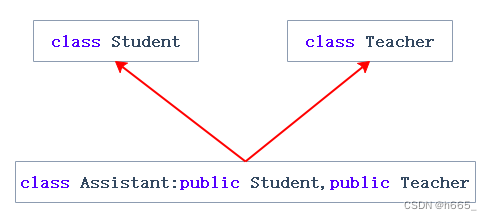【C++】继承
一、继承概念及定义
1. 继承概念
继承是面向对象程序设计中使代码可以复用的最重要的手段,它允许程序员在保持原有类特性的基础上进行扩展,增加功能,这样产生的新的类,称派生类,原有的类称为基类或者父类。
下面代码中student和teacher两个类都继承了person类,继承后,基类的成员函数和成员变量可以在子类中访问到。
class Person
{
public:
void Print()
{
cout << "name:" << _name << endl;
cout << "age:" << _age << endl;
}
protected:
string _name = "peter"; // 姓名
int _age = 18; // 年龄
};
// 继承后父类的Person的成员(成员函数+成员变量)都会变成子类的一部分。这里体现出了Student和Teacher复用了Person的成员。下面我们使用监视窗口查看Student和Teacher对象,可以看到变量的复用。调用Print可以看到成员函数的复用。
class Student : public Person
{
protected:
int _stuid; // 学号
};
class Teacher : public Person
{
protected:
int _jobid; // 工号
};
int main()
{
Student s;
Teacher t;
s.Print();
t.Print();
return 0;
}
2.继承定义
2.1 定义格式
下面我们看到Person是父类,也称作基类。Student是子类,也称作派生类。

2.2 继承关系和访问限定符
继承的方式有:公有、保护和私有三种,和类内部的访问限定符一样,所以组合后子类对基类成员访问的方式有九种。
1.基类private成员在派生类中无论以什么方式继承都是不可见的。这里的不可见是指基类的私有成员还是被继承到了派生类对象中,但是语法上限制派生类对象不管在类里面还是类外面都不能去访问它。
2.基类private成员在派生类中是不能被访问的,如果基类成员不想在类外直接被访问,但需要在派生类中能访问,就定义为protected。可以看出保护限定符是因继承才出现的。
3.实际上面的表格我们进行一下总结会发现,基类的私有成员在子类都是不可见的。积累的其他成员在子类中的访问方式==min(成员在基类的访问限定符,继承方式),public > protected > private。
4.使用关键字class时默认的继承方式是private,使用struct时默认的继承方式是public,不过最好显示的写出继承方式。
5.在实际运用中一般使用的都是public继承,几乎很少使用protected/private继承,也不推荐使用,因为这样继承下来的成员都只能在派生类的类里面使用,实际扩展维护性不强。
二、基类和派生类对象赋值转换
- 派生类对象可以直接赋值给基类的对象/基类的指针/基类的引用。这里有个形象的说法叫切片或者切割。寓意吧派生类中父类那部分切来赋值过去。
- 基类对象不能赋值给派生类对象。
class Person
{
protected:
string _name; // 姓名
string _sex; // 性别
int _age; // 年龄
};
class Student : public Person
{
public:
int _No; // 学号
};
void Test()
{
Student sobj;
// 1.子类对象可以赋值给父类对象/指针/引用
Person pobj = sobj;
Person* pp = &sobj;
Person& rp = sobj;
//2.基类对象不能赋值给派生类对象
//sobj = pobj;
// 3.基类的指针可以通过强制类型转换赋值给派生类的指针
pp = &sobj;
Student * ps1 = (Student*)pp; // 这种情况转换时可以的。
ps1->_No = 10;
pp = &pobj;
Student* ps2 = (Student*)pp; // 这种情况转换时虽然可以,但是会存在越界访问的问题
ps2->_No = 10;
}
切片的过程不会产生临时变量,是一个天然的过程。
int main()
{
Person p;
Student s;
Person& p = s; //如果产生临时变量则必须使用const引用
int a = 3;
const double& b = a;
return 0;
}
三、继承中的作用域
1.在继承体系中基类和派生类有独立的作用域。
2.当子类和父类中有名字相同的成员变量或函数时,子类会屏蔽父类对同名成员的直接访问,优先调用子类的同名成员,这种情况叫隐藏或重定义。
class Person
{
protected:
string _name = "hehe";
int _num = 111;
};
class Student : public Person
{
public:
void Print()
{
cout << " 姓名:" << _name << endl;
cout << " 身份证号:" << Person::_num << endl;
cout << " 学号:" << _num << endl;
}
protected:
int _num = 999;
};
int main()
{
Student s;
s.Print();
return 0;
}
上面展示了成员变量名相同时的隐藏,下面时对成员函数的隐藏,只要函数名相同,无论其参数列表是否相同都会构成隐藏。此时参数列表不同,函数名相同并不会构成重载,构成重载函数的前提是必须在同一个作用域。
// B中的fun和A中的fun不是构成重载,因为不是在同一作用域
// B中的fun和A中的fun构成隐藏,成员函数满足函数名相同就构成隐藏。
class A
{
public:
void fun()
{
cout << "func()" << endl;
}
};
class B : public A
{
public:
void fun(int i)
{
A::fun();
cout << "func(int i)->" << i << endl;
}
};
void Test()
{
B b;
b.fun(10);
};
四、派生类的默认成员函数
- 派生类的构造函数必须调用基类的构造函数初始化基类的那一部分成员,不能在自己的构造函数里直接初始化基类成员。如果基类有默认构造函数,那我们不需要管基类成员的初始化,编译器会自动调用基类的默认构造函数。如果基类没有默认构造函数,则必须在派生类构造函数的初始化列表阶段显示调用基类的有参构造。
- 派生类的拷贝构造函数必须调用基类的拷贝构造完成基类的拷贝初始化。
- 赋值重载和拷贝构造有些不同,因为赋值重载函数名在父类和子类中的函数名相同,所以在调用基类的赋值重载时必须指定基类域,否则会导致死循环调用子类的赋值重载,最终堆栈溢出。
- 派生类的析构函数会在调用完成后自动调用基类的析构函数清理基类成员。因为这样才能保证派生类对象先清理派生类成员再清理基类成员的顺序。
- 派生类对象初始化先调用基类构造再调派生类构造。
- 派生类对象析构清理先调用派生类析构再调基类的析构。
class Person
{
public:
Person(const char* name = "peter")
: _name(name)
{
cout << "Person()" << endl;
}
Person(const Person& p)
: _name(p._name)
{
cout << "Person(const Person& p)" << endl;
}
Person& operator=(const Person& p)
{
cout << "Person operator=(const Person& p)" << endl;
if (this != &p)
_name = p._name;
return *this;
}
~Person()
{
cout << "~Person()" << endl;
}
protected:
string _name; // 姓名
};
class Student : public Person
{
public:
Student(const char* name, int num)
: Person(name)
, _num(num)
{
cout << "Student()" << endl;
}
Student(const Student& s)
: Person(s)
, _num(s._num)
{
cout << "Student(const Student& s)" << endl;
}
Student& operator = (const Student& s)
{
cout << "Student& operator= (const Student& s)" << endl;
if (this != &s)
{
Person::operator =(s);
_num = s._num;
}
return *this;
}
~Student()
{
cout << "~Student()" << endl;
}
protected:
int _num; //学号
};
void Test()
{
Student s1("jack", 18);
Student s2(s1);
Student s3("rose", 17);
s1 = s3;
}
五、继承和友元
友元关系不能继承,也就是说基类友元不能访问子类的私有和保护函数。
class Student;
class Person
{
public:
friend void Display(const Person& p, const Student& s);
private:
string _name;
};
class Student : public Person
{
protected:
int _stuNum;
};
void Display(const Person& p, const Student& s)
{
cout << p._name << endl;
//cout << s.stuNum << endl; Display不是Student的友元,不能访问_stdNum
}
int main()
{
Person p;
Student s;
Display(p, s);
return 0;
}
六、继承和静态成员
基类定义了static静态成员,则整个继承体系里面只有一个这样的成员。无论派生出多少个子类,都只有一个static成员实例。
class Person
{
public:
Person() { ++_count; }
protected:
string _name; // 姓名
public:
static int _count; // 统计人的个数。
};
int Person::_count = 0;
class Student : public Person
{
protected:
int _stuNum; // 学号
};
class Graduate : public Student
{
protected:
string _seminarCourse; // 研究科目
};
void TestPerson()
{
Student s1;
Student s2;
Student s3;
Graduate s4;
cout << " 人数 :" << Person::_count << endl;
Student::_count = 0;
cout << " 人数 :" << Person::_count << endl;
}
七、复杂的菱形继承和菱形虚拟继承
1.菱形虚拟继承
多继承:一个子类有两个或两个以上直接父类时称这个继承关系为多继承。

菱形继承:多继承的一种特殊情况。

菱形继承时C++中的一个大坑,当_name被继承到Teacher和Student后,再被菱形继承到Assisant,则Assisant中会存在两份_name,在访问_name时会产生二义性,不知道要访问哪一个_name。想要避免二义性就要通过指定类域来解决,可是无法解决数据冗余的问题,因为Assisant中总不能有两个名字吧。
class Person
{
public:
string _name; // 姓名
};
class Student : public Person
{
protected:
int _num; //学号
};
class Teacher : public Person
{
protected:
int _id; // 职工编号
};
class Assistant : public Student, public Teacher
{
protected:
string _majorCourse; // 主修课程
};
void Test()
{
// 这样会有二义性无法明确知道访问的是哪一个
Assistant a;
a._name = "peter";
// 需要显示指定访问哪个父类的成员可以解决二义性问题,但是数据冗余问题无法解决
a.Student::_name = "xxx";
a.Teacher::_name = "yyy";
}
虚拟继承可以解决菱形继承的二义性和数据冗余的问题。如上面的继承关系,在Student和Teacher的继承Person时使用虚拟继承,即可解决问题。需要注意的是。虚拟继承不要在其他地方使用。
class Person
{
public:
string _name; // 姓名
};
class Student : virtual public Person
{
protected:
int _num; //学号
};
class Teacher : virtual public Person
{
protected:
int _id; // 职工编号
};
class Assistant : public Student, public Teacher
{
protected:
string _majorCourse; // 主修课程
};
void Test()
{
Assistant a;
a._name = "peter";
}
2.虚拟继承解决数据冗余和二义性的原理
为了研究虚拟继承的原理,我们给出了一个简化的菱形继承体系,再借助内存窗口观察对象成员的模型。
class A
{
public:
int _a;
};
//class B : virtual public A
class B : public A
{
public:
int _b;
};
//class C : virtual public A
class C : public A
{
public:
int _c;
};
class D : public B, public C
{
public:
int _d;
};
int main()
{
D d;
d.B::_a = 1;
d.C::_a = 2;
d._b = 3;
d._c = 4;
d._d = 5;
return 0;
}
下图是菱形虚拟继承的内存对象成员模型:这里可以分析出D对象将A放到了对象组成的最下面,这个A同时属于B和C。虚拟继承后,B和C不再直接存储成员,而是存储指针,这个指针指向指向一张表。这两个指针叫虚基表指针,这两个表叫虚基表。虚基表中存储的是偏移量,通过偏移量可以找到下面的A。

八、继承和组合
- public继承是一种is-a的关系,也就是说每个派生类对象都是一个基类对象。继承允许你根据基类的实现来定义派生类的实现。这种通过生成派生类的复用通常被称为白箱复用(white-box reuse)。术语“白箱”是相对可视性而言:在继承方式中,基类的内部细节对子类可见。继承一定程度破坏了基类的封装,基类的改变,对派生类有很大的影响。派生类和基类间的依赖关系很强,耦合度高。
- 组合是一种has-a的关系。假设B组合了A,每个B对象中都有一个A对象。对象组合是类继承之外的另一种复用选择。新的更复杂的功能可以通过组装和组合对象来获得。对象组合要求被组合的对象具有良好定义的接口。这种复用风格被称为黑箱复用(black-box reuse),因为对象的内部细节是不可见的。对象只以“黑箱”的形式出现。组合类之间没有很强的依赖关系,耦合度低。优先使用对象组合有助于你保持每个类被封装。
- 实际尽量多去用组合。组合的耦合度低,代码维护性好。不过继承也有用武之地,有些关系就适合继承那就用继承,另外要实现多态,也必须要继承。类之间的关系可以用继承,可以用组合,就用组合。
// Car和BMW Car和Benz构成is-a的关系
class Car {
protected:
string _colour = "白色"; // 颜色
string _num = "陕ABIT00"; // 车牌号
};
class BMW : public Car {
public:
void Drive() { cout << "好开-操控" << endl; }
};
class Benz : public Car {
public:
void Drive() { cout << "好坐-舒适" << endl; }
};
// Tire和Car构成has-a的关系
class Tire {
protected:
string _brand = "Michelin"; // 品牌
size_t _size = 17; // 尺寸
};
class Car {
protected:
string _colour = "白色"; // 颜色
string _num = "陕ABIT00"; // 车牌号
Tire _t; // 轮胎
};

